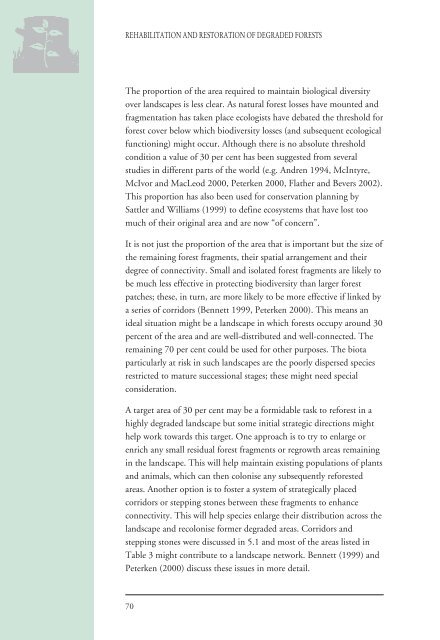Rehabilitation and Restoration Of Degraded Forests (PDF) - IUCN
Rehabilitation and Restoration Of Degraded Forests (PDF) - IUCN
Rehabilitation and Restoration Of Degraded Forests (PDF) - IUCN
You also want an ePaper? Increase the reach of your titles
YUMPU automatically turns print PDFs into web optimized ePapers that Google loves.
REHABILITATION AND RESTORATION OF DEGRADED FORESTS<br />
The proportion of the area required to maintain biological diversity<br />
over l<strong>and</strong>scapes is less clear. As natural forest losses have mounted <strong>and</strong><br />
fragmentation has taken place ecologists have debated the threshold for<br />
forest cover below which biodiversity losses (<strong>and</strong> subsequent ecological<br />
functioning) might occur. Although there is no absolute threshold<br />
condition a value of 30 per cent has been suggested from several<br />
studies in different parts of the world (e.g. Andren 1994, McIntyre,<br />
McIvor <strong>and</strong> MacLeod 2000, Peterken 2000, Flather <strong>and</strong> Bevers 2002).<br />
This proportion has also been used for conservation planning by<br />
Sattler <strong>and</strong> Williams (1999) to define ecosystems that have lost too<br />
much of their original area <strong>and</strong> are now “of concern”.<br />
It is not just the proportion of the area that is important but the size of<br />
the remaining forest fragments, their spatial arrangement <strong>and</strong> their<br />
degree of connectivity. Small <strong>and</strong> isolated forest fragments are likely to<br />
be much less effective in protecting biodiversity than larger forest<br />
patches; these, in turn, are more likely to be more effective if linked by<br />
a series of corridors (Bennett 1999, Peterken 2000). This means an<br />
ideal situation might be a l<strong>and</strong>scape in which forests occupy around 30<br />
percent of the area <strong>and</strong> are well-distributed <strong>and</strong> well-connected. The<br />
remaining 70 per cent could be used for other purposes. The biota<br />
particularly at risk in such l<strong>and</strong>scapes are the poorly dispersed species<br />
restricted to mature successional stages; these might need special<br />
consideration.<br />
A target area of 30 per cent may be a formidable task to reforest in a<br />
highly degraded l<strong>and</strong>scape but some initial strategic directions might<br />
help work towards this target. One approach is to try to enlarge or<br />
enrich any small residual forest fragments or regrowth areas remaining<br />
in the l<strong>and</strong>scape. This will help maintain existing populations of plants<br />
<strong>and</strong> animals, which can then colonise any subsequently reforested<br />
areas. Another option is to foster a system of strategically placed<br />
corridors or stepping stones between these fragments to enhance<br />
connectivity. This will help species enlarge their distribution across the<br />
l<strong>and</strong>scape <strong>and</strong> recolonise former degraded areas. Corridors <strong>and</strong><br />
stepping stones were discussed in 5.1 <strong>and</strong> most of the areas listed in<br />
Table 3 might contribute to a l<strong>and</strong>scape network. Bennett (1999) <strong>and</strong><br />
Peterken (2000) discuss these issues in more detail.<br />
70

















